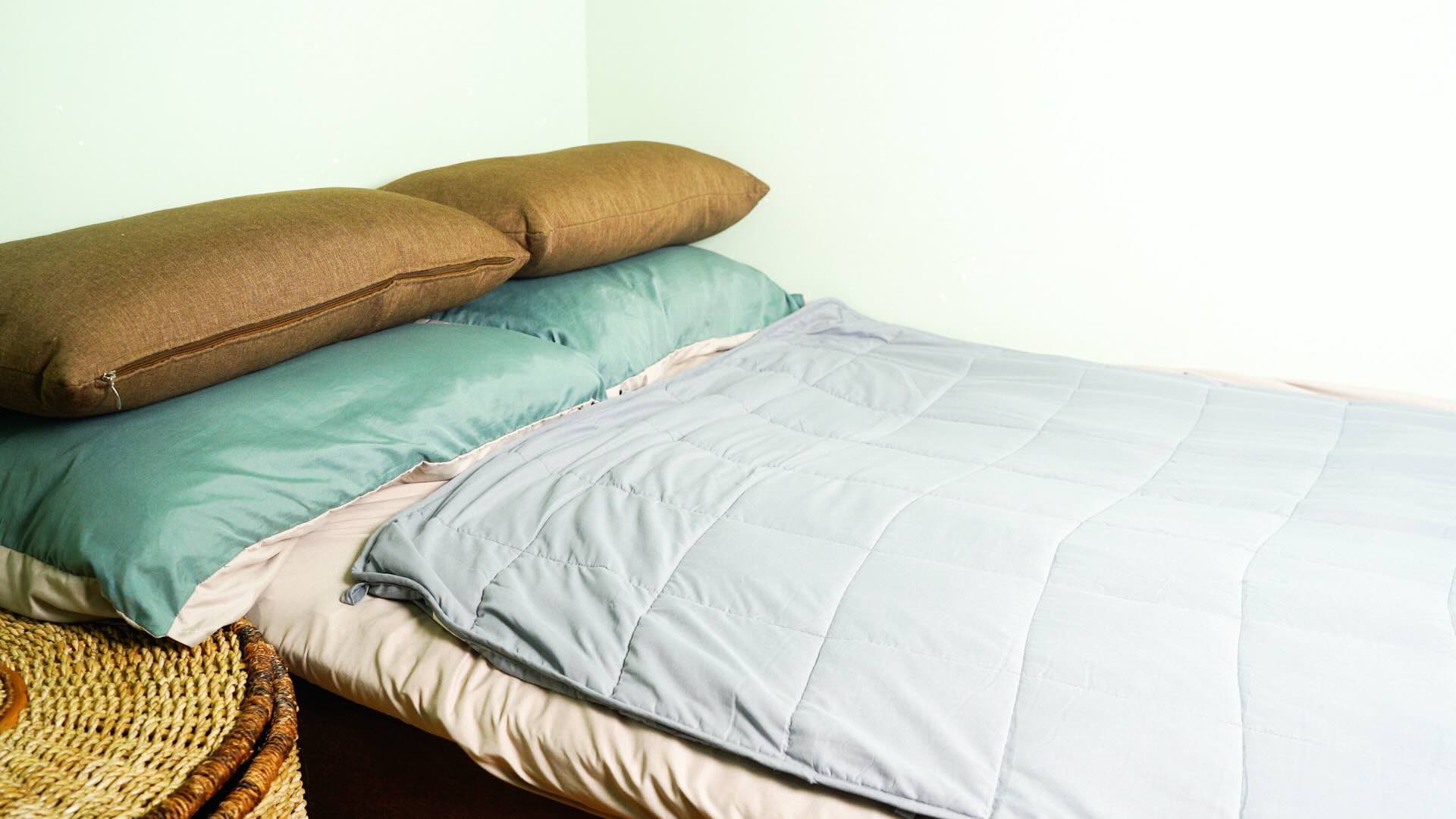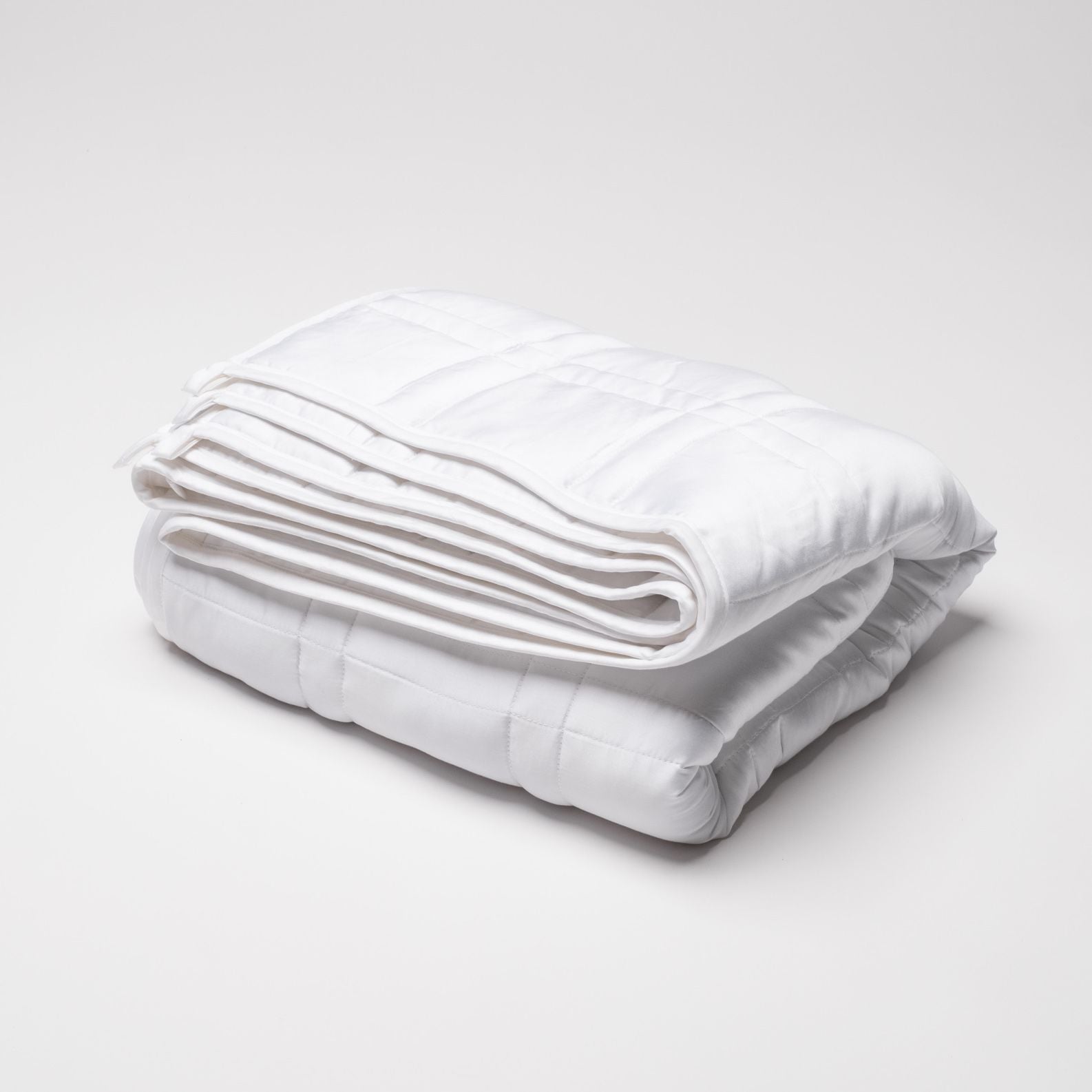Home>Articles>How To Put A Duvet Cover On A Weighted Blanket


Articles
How To Put A Duvet Cover On A Weighted Blanket
Modified: October 21, 2024
Discover an easy step-by-step guide on how to put a duvet cover on a weighted blanket. Read our informative articles for helpful tips and tricks.
(Many of the links in this article redirect to a specific reviewed product. Your purchase of these products through affiliate links helps to generate commission for Storables.com, at no extra cost. Learn more)
Introduction
Weighted blankets have gained popularity in recent years for their ability to provide comfort and promote relaxation. These blankets are filled with small weights or materials like glass beads or plastic pellets, providing a gentle, calming pressure when draped over the body. They have been found to be particularly beneficial for individuals with anxiety, insomnia, or sensory processing disorders.
One aspect of owning a weighted blanket is ensuring proper maintenance and cleanliness. A great way to keep your weighted blanket fresh and clean is to use a duvet cover. Duvet covers not only protect the blanket from dirt, stains, and wear, but they also offer the opportunity to switch up the look and style of your blanket.
Putting a duvet cover on a regular blanket can be a relatively simple task. However, when it comes to a weighted blanket, the process can be a bit trickier due to its weight and bulkiness. Many people struggle with getting the duvet cover on without the blanket sliding around or the corners bunching up.
In this article, we will guide you through the step-by-step process of putting a duvet cover on a weighted blanket with ease and efficiency. By following these instructions, you’ll be able to enjoy a clean and stylish weighted blanket without the hassle and frustration.
Key Takeaways:
- Installing a duvet cover on a weighted blanket can be made easy by following a step-by-step process, ensuring a clean, stylish, and snug fit for a comfortable and visually appealing bedding experience.
- Choosing the right duvet cover for a weighted blanket involves considering factors such as size, material, closure type, design, and ease of maintenance, allowing for personalization and protection of the investment.
Read more: How To Put A Blanket In Duvet
Understanding Weighted Blankets
Before diving into the process of putting a duvet cover on a weighted blanket, it’s essential to have a basic understanding of what weighted blankets are and how they work. Weighted blankets are designed to provide deep touch pressure simulation, which can help promote relaxation and reduce anxiety and stress.
Weighted blankets are typically filled with small weights, such as glass beads or plastic pellets, evenly distributed throughout the blanket. The weight of the blanket can vary, ranging from a few pounds to over 20 pounds, depending on individual preferences and needs. The added weight of the blanket helps create a gentle, consistent pressure that may mimic the feeling of being hugged or held.
Many people find the use of weighted blankets to be comforting and therapeutic. The deep touch pressure provided by these blankets can help increase the production of serotonin, a neurotransmitter that contributes to feelings of relaxation and well-being. This can result in a calmer state of mind and improved sleep quality.
Weighted blankets are commonly used by individuals who struggle with anxiety, insomnia, restless leg syndrome, sensory processing disorders, or stress-related conditions. The pressure provided by the blanket can have a calming effect on the nervous system, helping to reduce anxiety and promote better sleep.
It’s important to note that weighted blankets are not suitable for everyone. They may not be recommended for individuals with certain medical conditions, such as respiratory problems, circulatory issues, or mobility limitations. It’s always best to consult with a healthcare professional before using a weighted blanket, especially if you have any underlying health concerns.
Now that we have a better understanding of what weighted blankets are and their potential benefits, let’s move on to the next section, which highlights the advantages of using a duvet cover for your weighted blanket.
Benefits of Using a Weighted Blanket
Weighted blankets offer a range of benefits that make them a popular choice for individuals seeking comfort and relaxation. Here are some of the key advantages of using a weighted blanket:
1. Better Sleep: Many people struggle with getting quality sleep due to insomnia or restless nights. The gentle, deep pressure provided by a weighted blanket can help promote feelings of relaxation and calmness, aiding in falling asleep faster and staying asleep throughout the night.
2. Reduced Anxiety and Stress: The deep touch pressure stimulation from a weighted blanket has been found to have an anxiety-reducing effect. The comforting weight can help lower stress levels, soothe the nervous system, and provide a sense of security and safety.
3. Improved Mood: Weighted blankets are believed to increase the production of serotonin and dopamine, neurotransmitters responsible for regulating mood. This can potentially help elevate mood, reduce feelings of depression, and enhance overall well-being.
4. Sensory Support: Individuals with sensory processing disorders often find comfort in the deep pressure provided by weighted blankets. This added sensory input can help individuals better regulate their sensory experiences and decrease sensory overload.
5. Enhanced Focus and Attention: Weighted blankets have been used as a tool to improve focus and attention in individuals with conditions like ADHD. The gentle pressure can help calm restlessness, reduce fidgeting, and promote a more focused state of mind.
6. Pain Relief: The pressure applied by a weighted blanket can have a soothing effect on muscle tension and joint pain. This makes weighted blankets beneficial for individuals with conditions like fibromyalgia, arthritis, or chronic pain.
7. Versatility and Customization: Weighted blankets come in various sizes, weights, and designs, allowing for personalization based on individual preferences. Additionally, using a duvet cover makes it easy to change the style and appearance of the blanket, adding versatility to its use.
By using a duvet cover on your weighted blanket, you not only protect your investment but also enhance its benefits. The next section will guide you through the process of choosing the right duvet cover for your weighted blanket.
Choosing the Right Duvet Cover for a Weighted Blanket
When it comes to selecting a duvet cover for your weighted blanket, there are a few important factors to consider. Here are some guidelines to help you choose the right duvet cover:
1. Size: Ensure that the duvet cover is the appropriate size for your weighted blanket. It should fit snugly without being too tight or too loose. Measure the dimensions of your blanket and select a duvet cover that matches those measurements.
2. Material: Opt for a duvet cover made from a durable and comfortable material. Popular choices include cotton, linen, microfiber, and blends. Consider the breathability and softness of the fabric to ensure optimal comfort.
3. Closure Type: Duvet covers typically come with different closure types, such as buttons, zippers, or ties. Choose a closure type that is convenient for you and will keep the duvet cover securely in place.
4. Design and Style: Select a duvet cover that complements your personal aesthetic and matches the decor of your bedroom. Whether you prefer solid colors, patterns, or prints, there is a wide variety of options available to suit your taste.
5. Easy to Clean: Look for a duvet cover that is easy to clean and maintain. Check the care instructions to ensure that it can be machine washed and dried without losing its quality or shape.
6. Quality and Durability: Investing in a high-quality duvet cover will ensure its longevity and resistance to wear and tear. Consider customer reviews and ratings to gauge the durability and overall quality of the duvet cover.
By taking these factors into account, you can choose a duvet cover that not only fits your weighted blanket perfectly but also meets your preferences in terms of comfort, style, and maintenance. With the right duvet cover selected, you’re now ready to begin the process of putting it on your weighted blanket.
Preparing the Duvet Cover for Installation
Before you begin the process of putting the duvet cover on your weighted blanket, it’s important to properly prepare the cover. Follow these steps to ensure a smooth installation:
1. Wash and Dry: If your duvet cover is brand new, it’s a good idea to wash and dry it according to the care instructions. This will help remove any wrinkles, odors, or residues from the fabric and prepare it for installation.
2. Lay Flat: Lay the duvet cover on a flat surface, such as a bed or clean floor, with the inside of the cover facing up. Smooth out any wrinkles or folds to ensure a neat and even installation.
3. Open the Closure: If your duvet cover has a zipper or buttons, unzip or unbutton the closure completely. If it has ties, untie them and unfold the flaps to expose the interior of the cover.
4. Duvet Cover Orientation: Take note of the orientation of the duvet cover. The top and bottom edges should be clearly marked or identifiable so that you know which way to align it with your weighted blanket.
5. Get Familiar with the Corners: Locate the four corners of the duvet cover and familiarize yourself with their placement. This will help you align the cover correctly with the corners of your weighted blanket during the installation process.
By following these preparatory steps, you’ll be ready to begin the process of putting the duvet cover on your weighted blanket. The next section will guide you through each step in detail to ensure a successful installation.
Step 1: Turning the Cover Inside Out
The first step in putting a duvet cover on a weighted blanket is to turn the cover inside out. This may seem counterintuitive, but it allows for easier attachment of the blanket and ensures a smooth and even fit. Follow these instructions to turn the duvet cover inside out:
1. Locate the Opening: Find the opening or closure of the duvet cover, whether it’s a zipper, buttons, or ties. This is where you will be inserting your weighted blanket.
2. Gather the Corners: Gather all four corners of the duvet cover in your hands. Hold the corners firmly but gently to prevent the cover from slipping or bunching up.
3. Flip the Cover: Carefully flip the duvet cover inside out by pulling the corners through the opening. Continue to pull until the entire cover is turned inside out.
4. Smooth out Wrinkles: Once the duvet cover is inside out, take a moment to smooth out any wrinkles or creases. This will ensure a neat and tidy appearance when the cover is flipped back to its original position.
5. Inner Layer Placement: If your duvet cover has a specific inner layer or lining, make sure it is properly aligned and facing outward once the cover is inside out.
6. Shake and Adjust: Give the inside out cover a gentle shake to help it fully settle and align. Take a few moments to adjust and smooth out the cover, making sure there are no twisted or bunched areas.
By turning the duvet cover inside out, you create a pocket-like structure that will easily accommodate your weighted blanket. This sets the stage for the next step, aligning the top corners of the blanket and cover.
Turn the duvet cover inside out and lay it flat on the bed. Lay the weighted blanket on top, then roll both together like a burrito. Flip the open end of the cover over the ends of the roll and unroll.
Step 2: Aligning the Top Corners of the Blanket and Cover
Once you have turned the duvet cover inside out, the next step is to align the top corners of the weighted blanket and the cover. This ensures that the blanket remains in place while you continue the installation process. Follow these instructions to align the corners:
1. Find the Top Edge: Locate the top edge of your weighted blanket. Some blankets may have labels or markings that indicate the top side. If not, you can determine the top by the positioning of any stitching or pattern design.
2. Insert the Blanket Corner: Hold the top corner of the weighted blanket and insert it into the corresponding top corner of the turned inside out duvet cover. Make sure the corner of the blanket goes all the way into the corner of the cover.
3. Smooth Out Any Bunching: As you insert the blanket corner into the cover corner, be mindful of any bunching or twisting. Smooth out the fabric to ensure a clean and even alignment.
4. Repeat with the Opposite Corner: Move to the opposite top corner of the weighted blanket and insert it into the corresponding corner of the duvet cover. Again, smooth out any bunching or twisting to achieve a seamless alignment.
5. Check Alignment: Take a moment to check the alignment of the top corners. Ensure that both corners are securely inserted into the cover corners and that the blanket is evenly spread out within the cover.
6. Adjust if Necessary: If the alignment is not perfect, gently adjust the corners to create a straight and even alignment. Pay attention to any bunching or twisting along the edges and smooth out the fabric as needed.
By aligning the top corners of the weighted blanket and the duvet cover, you establish a solid foundation for the installation process. In the next step, we will secure the top corners in place using ties or clips to prevent any shifting during use.
Step 3: Securing the Top Corners with Ties or Clips
After aligning the top corners of the weighted blanket and the duvet cover, the next step is to secure them in place to prevent any shifting or bunching. This can be done using ties or clips specifically designed for duvet covers. Follow these instructions to secure the top corners:
1. Determine the Type of Closure: Check the duvet cover for ties, clips, or other fastening mechanisms located near the top corners. These closures are designed to hold the top corners of the blanket in place.
2. Tie the Ties or Clip the Clips: If your duvet cover has ties, gather the fabric of the cover and the weighted blanket near the top corners and tie the ties together into a secure knot. If your duvet cover has clips, simply clip them onto both the cover and the blanket.
3. Ensure a Firm Hold: Make sure that the ties are tightly secured or the clips are firmly attached. This will prevent the weighted blanket from shifting or coming loose inside the duvet cover during use.
4. Repeat on the Opposite Side: Move to the opposite top corner and secure it with ties or clips in the same manner as the first corner. Ensure that both corners are equally tight and well-fastened to maintain the alignment.
5. Adjust if Necessary: Once both top corners are secured, take a moment to check the overall alignment and tension of the duvet cover. If needed, make any adjustments to ensure that the fabric is smooth and evenly distributed.
6. Verify the Security: Give the secured corners a gentle tug to ensure they are securely fastened. This will help provide peace of mind that the weighted blanket will stay in place during use.
By securing the top corners of the weighted blanket with ties or clips, you minimize the chances of the blanket moving around inside the duvet cover. This step sets the stage for the next step, where we will roll the blanket and cover together for easier installation.
Step 4: Rolling the Blanket and Cover Together
Once the top corners of the weighted blanket and the duvet cover are secured, the next step is to roll the blanket and cover together. This method allows for easier installation and ensures that the duvet cover envelops the blanket evenly. Follow these instructions to roll the blanket and cover together:
1. Start at the Top: Begin at the top of the blanket where the secured corners are located. Smooth out any wrinkles or folds along the surface of the duvet cover and blanket to create a nice, even base.
2. Roll Downwards: Start rolling the blanket and cover together towards the bottom edge. Maintain a tight roll to keep the duvet cover securely wrapped around the weighted blanket.
3. Keep It Neat: As you roll, make sure to maintain an even alignment and tension. Smooth out any wrinkles or creases that may form during the rolling process. This will help create a neat and tidy final result.
4. Check for Bunching: Periodically stop and check for any bunching or misalignment as you roll. If you notice any issues, pause and adjust the fabric to ensure a smooth and even roll. This will help prevent any discomfort while using the weighted blanket.
5. Continue Rolling: Roll the blanket and cover together until you reach the bottom edge. Ensure that the duvet cover is tightly wrapped around the blanket and that there are no loose or hanging portions of the fabric.
6. Secure the Rolled Blanket: Once the blanket and cover are completely rolled together, secure the roll using ties, clips, or a large elastic band. This will keep the blanket and cover tightly wrapped and prevent them from unraveling during use.
By rolling the weighted blanket and duvet cover together, you create a compact package that is easier to handle and install onto your bed. In the next step, we will unroll the blanket and adjust the duvet cover for a proper fit.
Read more: How To Put On An IKEA Duvet Cover
Step 5: Unrolling and Adjusting the Duvet Cover
Once the weighted blanket and duvet cover are securely rolled together, it’s time to unroll and adjust them for a proper fit. Follow these instructions to unroll the blanket and adjust the duvet cover:
1. Place on the Bed: Start by placing the rolled blanket and cover onto your bed or desired surface. Position it at the bottom edge, where you want the top of the bed to be.
2. Unroll Carefully: Begin unrolling the blanket and cover, moving from the bottom edge towards the top. Be cautious of any twisting or bunching of the fabric. Unroll slowly and gently to maintain control over the process.
3. Smooth Out Any Wrinkles: As the blanket and cover unroll, smooth out any wrinkles or creases that may appear. Smooth the fabric with your hands or gently shake the blanket to help distribute the cover evenly and ensure a neat appearance.
4. Adjust the Duvet Cover: Once the blanket is fully unrolled, adjust the duvet cover to ensure a proper fit. Pull the cover towards the edges of the bed, making sure it extends to each side and covers the entire blanket without any gaps.
5. Align the Corners: Pay attention to the corners of the duvet cover as you adjust it. Ensure that the corners align with the corners of the weighted blanket. Smooth out any fabric or tuck in any excess material to maintain a clean and seamless look.
6. Smooth and Flatten: Use your hands or a gentle tug to smooth out any remaining wrinkles or folds in the duvet cover. Make sure the cover lays flat against the weighted blanket, creating a comfortable and visually appealing surface.
By unrolling and adjusting the duvet cover, you ensure that the weighted blanket is fully encased and that the cover fits snugly and securely. This brings us to the end of the installation process. Congratulations! Your weighted blanket is now ready to provide comfort, relaxation, and a stylish addition to your sleep routine.
Conclusion
Putting a duvet cover on a weighted blanket may initially seem like a challenging task, but with the right guidance, it can be a straightforward and rewarding process. By following the step-by-step instructions outlined in this article, you can easily and effectively install a duvet cover on your weighted blanket.
A duvet cover not only protects your weighted blanket from dirt and wear but also adds versatility and style to your bedding. It allows you to easily change the look and feel of your blanket, giving you the freedom to match your bedroom decor or personal preferences.
Before beginning the installation process, it’s important to understand the benefits of using a weighted blanket. These blankets are designed to provide deep touch pressure stimulation, which can help promote relaxation, reduce anxiety, and improve sleep quality. They have been found to be particularly beneficial for individuals with anxiety disorders, insomnia, or sensory processing issues.
When choosing a duvet cover for your weighted blanket, remember to consider factors such as size, material, closure type, design, and ease of maintenance. These considerations will ensure that you select a cover that fits your blanket well and meets your style and functional preferences.
Once you have the appropriate duvet cover, the installation process involves turning the cover inside out, aligning the top corners of the blanket and cover, securing the corners with ties or clips, rolling the blanket and cover together, and finally unrolling and adjusting the duvet cover for a proper fit.
By following these steps with care and attention, you can enjoy a fully covered and snugly fitted weighted blanket. The process may require a bit of patience and practice, but the end result will be a clean, comfortable, and visually appealing weighted blanket that promotes restful sleep and relaxation.
Remember to check the manufacturer’s instructions for your specific weighted blanket and duvet cover, as they may provide additional guidance and recommendations for installation and care.
Now that you have mastered the art of putting a duvet cover on a weighted blanket, you can enjoy all the benefits that come with using this therapeutic, cozy, and stylish bedding accessory.
Frequently Asked Questions about How To Put A Duvet Cover On A Weighted Blanket
Was this page helpful?
At Storables.com, we guarantee accurate and reliable information. Our content, validated by Expert Board Contributors, is crafted following stringent Editorial Policies. We're committed to providing you with well-researched, expert-backed insights for all your informational needs.














0 thoughts on “How To Put A Duvet Cover On A Weighted Blanket”